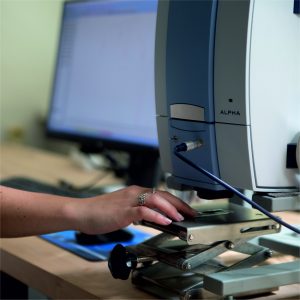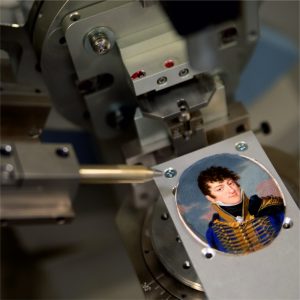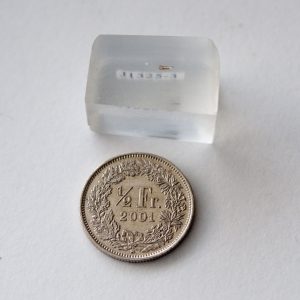Advanced non-invasive and micro-analytical techniques and approaches in cultural heritage studies
Contact person: David Hradil
Materials analysis is a key and very critical element for all professions, which act in the field of tangible cultural heritage research, conservation/restoration and protection. For example, it helps restorers to find out which materials or painting layers are original and which are overpaints, or, for art historians, the dating and provenance are important to verify. Technologists want to know which solvent has to be used to clean the surface and curators try to optimize climatic conditions to avoid risk of materials degradation by light, humidity or, e.g., salts. Due to a number of complicating factors (such as, e.g., small sample sizes, heterogeneity, necessity of non-invasive and non-destructive approaches only, etc.), misinterpretations are common in analysis performed solely on service bases. Therefore, methodological research is necessary for each single question or type of material, and also in view of the ever-expanding possibilities of analytical instrumentations.
We focus on the analysis of painted artworks, especially on the composition of colours – pigments and organic binders. We follow current trends, particularly in the development and testing of hybrid devices (combining multiple types of information in one device – for example, internal structure imaging and elemental mapping) and wider use of portable lightweight devices (e.g., infrared, Raman or x-ray fluorescence spectrometers). It enables efficient data collection in situ (i.e., without transportation of an artwork) and provides a basis for decision of targeted sampling, reducing the number of samples significantly. When analysing micro-fragments of paints (often prepared in the form of polished cross-sections), we emphasize the role of non-traditional methods whose potential has not yet been exploited. A typical example is testing and application of powder x-ray microdiffraction (micro-pXRD) for structural analysis of crystalline compounds, provenance analysis of mineral pigments or phase transitions during alteration processes. Critical evaluation of limits is always related to specific types of tasks – as an example the limits of Raman micro-spectroscopy (otherwise very popular and widely used) in the analysis of clay pigments or complicated pigment mixtures in modern painting (F. Kupka, E. Munch) can be shown.
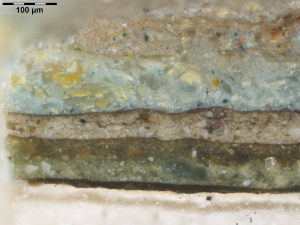
Fig. 4 Cross-sectional view of the paint layers’ sequence („stratigraphy“) – visible light (photo J. Hradilová)
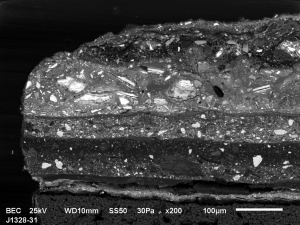
Fig. 5 Cross-sectional view of the paint layers’ sequence („stratigraphy“) – back-scattered electrons (photo S. Švarcová)
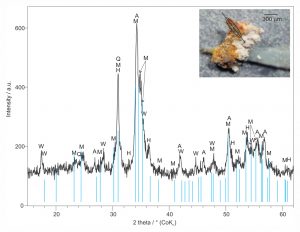
Fig. 6 Micro-XRPD pattern of highly degraded fragment from Gothic murals showing uncommon lead arsenate chloride – mimetite (M) as a secondary phase
References
Hradilová J., Hradil D., Pech M., Bezdička P., Neděla V., Tihlaříková E., Targowski P.: Complementary use of X-ray based imaging and analytical methods in the investigation of miniature portraits. Microhemical Journal 153 (2020) 104371, https://doi.org/10.1016/j.microc.2019.104371
Pospíšilová E., Novotný K., Pořízka P., Hradil D., Hradilová J., Kaiser J., Kanický V.: Depth-resolved analysis of historical painting model samples by means of laser-induced breakdown spectroscopy and handheld X-ray fluorescence. Spectrochimica Acta Part B 147 (2018), 100-108, https://doi.org/10.1016/j.sab.2018.05.018
Košařová V., Hradil D., Hradilová J., Čermáková Z., Němec I., Schreiner M.: The efficiency of micro-Raman spectroscopy in the analysis of complicated mixtures in modern paints: Munch’s and Kupka’s paintings under study. Spectrochimica Acta Part A 156 (2016), 36-46, https://doi.org/10.1016/j.saa.2015.11.027
Hradil D., Bezdička P., Hradilová J., Vašutová V.: Microanalysis of clay-based pigments in paintings by XRD techniques. Microchemical Journal 125 (2016), 10-20, https://doi.org/10.1002/jrs.4381
Čermáková Z., Bezdička P., Němec I., Hradilová J., Šrein V., Blažek J., Hradil D.: Naturally irradiated fluorite as a historic violet pigment: Raman spectroscopic and X-ray diffraction study. Journal of Raman Spectroscopy 46 (2015), 236-243, https://doi.org/10.1002/jrs.4627
